
The Gorges family was a gentry family established in the southwest of England. [2]

The Gorges family was a gentry family established in the southwest of England. [2]
Believed to have come from Gorges in Normandy, the first documented member was Sir Ralph Gorges (died 1272) who held the manor of Wraxall in Somerset. He married Eleanor Morville (died 1291), who apparently brought into the family the manors of Bradpole in Dorset and Knighton on the Isle of Wight. They had a daughter Eleanor, who married Sir John Maltravers (died 1341) and became the mother of John Maltravers, 1st Baron Maltravers, together with a son Sir Ralph Gorges (died 1297) who was the father of Sir Ralph Gorges (died 1323), created Baron Gorges. [2]
His two daughters were his heiresses: Joan Gorges, who married Sir William Cheyne (died 1345) and was mother of Sir Ralph Cheyne, and Eleanor Gorges who married Sir Theobald Russell (died 1341), of Kingston Russell, son of Sir William Russell. She inherited the Gorges manors of Wraxall and Knighton, passing Wraxall to her younger son Theobald Russell (died 1380), later knighted, who adopted the surname and arms of Gorges and so continued the family line. [2]
The younger Theobald had a son Thomas Gorges (died 1403) who married Agnes Beauchamp (died 1419) and was father of Sir Theobald Gorges (died 1470). From his first marriage to Joan Hankford (died 1433), sister of Sir Richard Hankford, he left three children: Joan Gorges who married John Hatch (died 1476), Elizabeth Gorges who married Sir Thomas Grenville (died 1485), and his heir Walter Gorges. [3] [4] [5] [6] [7] [8] [9] [10] [11]

Walter Gorges' son was Sir Edmund Gorges (1454–1512), who married Anne Howard and became the father of Sir Edward Gorges (1481–1566). His son, from his second marriage to Mary Poyntz, was Sir Thomas Gorges (1536–1610) who acquired the manor of Longford in Wiltshire in 1573 and built there Longford Castle. He married (as her second husband) Helena Snakenborg, Marchioness of Northampton (1549–1635), a Swedish noblewoman and lady in waiting to Queen Elizabth I, through whose influence Swedish-style architecture was adopted in the construction of the mansion and who has a notable monument in Salisbury Cathedral.

Their son Edward Gorges was created a baronet in 1611 and obtained the barony of Dundalk in Ireland. Both he and his son Richard Gorges (died 1712) sat in the Parliament of Ireland for the constituency of Ratoath. Richard Gorges' tomb can be seen in the church of Stetchworth in Cambridgeshire.[ citation needed ]

In 1341 Theobald Russell "de Gorges” adopted the Gorges arms used by his uncle and grandfather, that is to say, those taken from their de Morville heiress who brought them Wraxall. In 1347 he was challenged by Sir John Warbleton (or Warburton), a knight from Cheshire who happened to be serving with him at the Siege of Calais, who noticed they both bore the same arms on their shields, "Lozengy or and azure" (a field of gold and blue lozenges). The case was brought before a court of honour convened at Calais and presided over by Henry of Grosmont, Earl of Lancaster which adjudged on 19 July 1347 the disputed arms to Warbleton. Theobald Russell "de Gorges" thus added a "chevron gules" (red chevron) to the de Morville arms as a difference, in order not to contravene the judgement. Thus the new Gorges arms, known as Gorges Modern, became "Lozengy or and azure, a chevron gules", [12] and one of the more celebrated and historic heraldic cases heard in a military court was recorded. This coat of arms was afterwards used by Sir Ferdinando Gorges. [13] The ancient Gorges canting arms of "Argent, a gurges azure", being a blue whirlpool on a white (or silver) background, gurges signifying in Latin a Whirlpool, [14] had been retained some generations before by the senior Gorges line seated at Tamerton Foliot, Devon, the cadet line having married the de Morville heiress.
The whirlpool arms as borne by the senior branch can be seen in Tamerton Foliot Church of St. Mary as a whorl in the 9th. quartering on the 1617 Coplestone funerary monument. The Coplestone family inherited Tamerton Foliot by marriage to a Gorges heiress. In the form of 3 concentric annulets the arms were formerly visible sculpted on the tunic of the adjacent knightly effigy, said by Raymond Gorges op.cit to represent John Gorges of Warleigh House, lord of the manor of Tamerton Foliot, who flourished at the start of the 15th century, and his wife. Fire damage has since removed all visible traces of any armorial bearings on the knight's tunic. A pair of the wooden roof bosses of the church at Chagford, Devon, display whorls, believed to be the Gorges arms, as the family was connected with that manor. [15] G.W. Ormerod, in his "Historical sketch of the Parish of Chagford", states that the Gorges family had "a great influence in the parish between 1439 and 1461 being descended in the female line from the Wibberi family".

Sir Ferdinando Gorges was a naval and military commander and governor of the important port of Plymouth in England. He was involved in Essex's Rebellion against the Queen, but escaped punishment by testifying against the main conspirators. His early involvement in English trade with and settlement of North America as well as his efforts in founding the Province of Maine in 1622 earned him the title of the "Father of English Colonization in North America," even though Gorges himself never set foot in the New World.

Kingston Russell House is a large mansion house and manor near Long Bredy in Dorset, England, west of Dorchester. The present house dates from the late 17th century but in 1730 was clad in a white Georgian stone facade. The house was restored in 1913, and at the same time the gardens were laid out.

Tamerton Foliot is a village and former civil parish situated in the north of Plymouth, in the Plymouth district, in the ceremonial county of Devon, England. It also lends its name to the ecclesiastical parish of the same name.
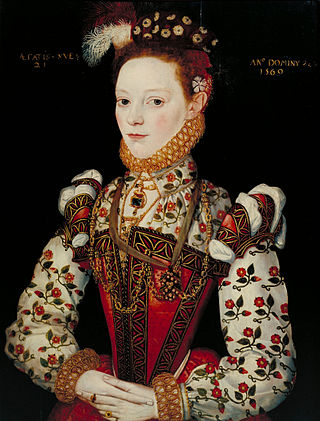
Elin Ulfsdotter Snakenborg, Marchioness of Northampton, also known as Helena, and Helena the Red for her red hair, was a Swedish-born noblewoman, Maid of Honour of Queen Elizabeth I of England, and Marchioness of Northampton by her marriage to William Parr, 1st Marquess of Northampton.

Sir John Bampfylde, 1st Baronet of Poltimore and North Molton and Tamerton Foliot, all in Devon, was an English lawyer and politician. He was one of Devonshire's Parliamentarian leaders during the Civil War.

Sir Thomas Gorges of Longford Castle in Wiltshire, was a courtier and Groom of the Chamber to Queen Elizabeth I. Via his great-grandmother Lady Anne Howard, a daughter of John Howard, 1st Duke of Norfolk, he was a second cousin of both Queens Anne Boleyn and Catherine Howard, the second and fifth wives of King Henry VIII. In 1586 he was elected as a Member of Parliament for Downton in Wiltshire.

Sir William Russell (1257–1311) was an English nobleman, knight, and holder of a moiety of the feudal barony of North Cadbury, Somerset, but spent most of his life engaged in the administration and defence of the Isle of Wight, where he obtained by marriage the manor of Yaverland. He served as constable of Carisbrooke Castle, and sat in parliament on two occasions, firstly as burgess for Great Bedwyn, Wiltshire, and then for the County of Southampton. As a baron his military service was called on several times by King Edward I Hammer of the Scots.
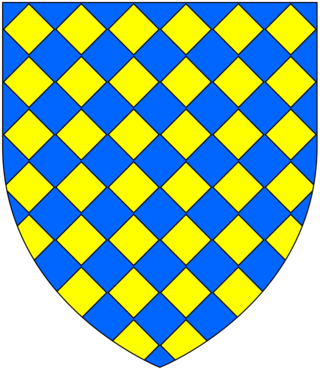
Warbelton v. Gorges was one of the earliest heraldic law cases brought concerning English armory, in 1347. It concerned the coat of arms blazoned Lozengy Or and azure, that is a field of yellow and blue lozenges. The arms were borne by the unrelated families of Warbelton, from Hampshire, and Gorges, from Somerset, apparently without knowledge of each other or their common usage, until John de Warbelton and Theobald de Gorges served together in the English army at the Siege of Calais in 1346/7. A gentleman's armorial bearings represented his very identity and were of enormous importance to him, both as a matter of family pride and for practical purposes of personal recognition in battle and in legal seals. Warbelton made a formal complaint to the officer appointed by the king to resolve such matters, namely Henry of Grosmont, Earl of Lancaster, seneschal of England, who was commanding the English forces. A 6-man court of honour was convened and the pair were cross-examined, with evidence being sought from knights of their own localities also serving at the siege.

Maurice Denys, Esquire, of Siston, Gloucestershire, was twice Sheriff of Gloucestershire in 1460 and 1461. The Denys family were stated by Sir Robert Atkyns, the 18th-century historian of Gloucestershire, to have provided more sheriffs for that county than any other family.
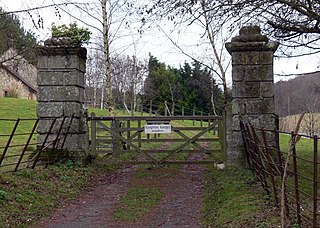
Knighton Gorges Manor was one of the grandest manor houses on the Isle of Wight, located in the hamlet of Knighton, near Newchurch.

The Denys monumental brass in Olveston Church, Gloucestershire, dates from 1505, and is one of only about 80 surviving monumental brasses in Gloucestershire. It was erected following the death of Sir Walter Denys in 1505, and shows the latter together with his father Maurice Denys, both Sheriffs of Gloucestershire. The Denys family were at various times lords of the manors of Alveston, Earthcott Green, Siston and Dyrham in Gloucestershire.
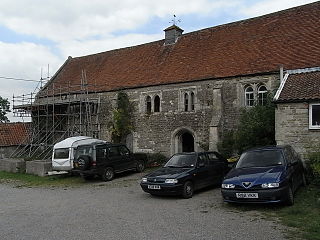
Brook in the parish of Heywood, north of Westbury in Wiltshire, England, is an historic estate. It was the seat of Robert Willoughby, 1st Baron Willoughby de Broke, KG, an important supporter of King Henry VII, whose title unusually incorporates the name of his seat, in order to differentiate him from his ancestors Barons Willoughby of Eresby, seated at Eresby Manor near Spilsby in Lincolnshire. A medieval wing survives of the mansion house known as Brook Hall, a Grade I listed building which stands near the Biss Brook.

Sir Thomas Grenville II, K.B.,, lord of the manors of Stowe in Kilkhampton, Cornwall and Bideford, Devon, Sheriff of Cornwall in 1481 and 1486. During the Wars of the Roses, he was a Lancastrian supporter who had taken part in the conspiracy against Richard III, organised by the Duke of Buckingham. On the accession of King Henry VII (1485–1509) to the throne, Sir Thomas was appointed one of the Esquires of the Body to Henry VII. On 14 November 1501 upon the marriage of Prince Arthur to Katherine of Aragon, he was created a Knight of the Bath. He served on the Commission of the Peace for Devon from 1510 to his death in circa 1513.
The manor of Bideford in North Devon was held by the Grenville family between the 12th and 18th centuries. The full descent is as follows:

The Manor of Poltimore is a former manor in Devon, England. The manor house known as Poltimore House survives in its 18th-century remodelled form, but has been dilapidated for several decades. A charity named the "Poltimore House Trust" has been established for the purpose of its restoration. The manor was situated within the historic Wonford Hundred and was largely coterminous with the parish of Poltimore and contained the village of Poltimore, 4 miles (6.4 km) north-east of the historic centre of the City of Exeter. It should not be confused with the eponymous Devon estate of Poltimore in the parish of Farway, 16 miles (26 km) east of Exeter. Poltimore was the principal seat of the Bampfylde family from c. 1300 to 1920.

Warleigh is an historic estate within the parish of Bickleigh in Devon, about 6 miles from Plymouth. Warleigh House, the manor house of the manor of Tamerton Foliot is situated one mile west of that village on the south-east bank of the River Tavy where it joins the River Tamar. It was remodelled in about 1830 in the Gothic style by John Foulston and has been listed Grade II* on the National Heritage List for England since 1960.

St Andrew's Church in Bere Ferrers, Devon, is a parish church in the Church of England The church contains the oldest stained-glass window in Devon, dated at 600 years old. The building was probably built at various times between 1290 and 1340; it is recorded that an archpresbytery was founded here in 1333 and the north transept appears to be the earliest part of the church while the south aisle is the latest, perhaps 15th century.
Budockshed is a historic estate in the parish of St Budeaux, near Plymouth in Devon, England.
Ivo de Morville, Lord of Knighton, Bradpole and Wraxall, was an English noble.
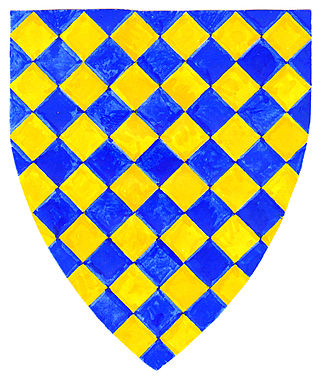
Baron Gorges was a title created in the Peerage of England for the soldier Sir Ralph Gorges, of Wraxall in Somerset, who was summoned to Parliament as a baron in 1309. On the death of his son without children in 1344, any hereditary title expired.
{{cite book}}: CS1 maint: location missing publisher (link)